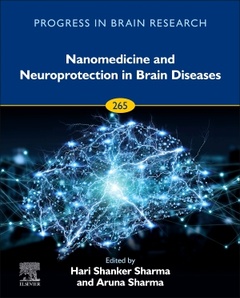Description
Nanomedicine and Neuroprotection in Brain Diseases
Progress in Brain Research Series
Coordinators: Sharma Hari Shanker, Sharma Aruna
Language: English
Subjects for Nanomedicine and Neuroprotection in Brain Diseases:
Keywords
Alzheimer's disease; Anlotinib; Blood-brain barrier; Brain edema; Brain pathology; Cancer cells; Cancer stem cells; Carbon monoxide; Cardiac arrest; Cell therapy; Cerebral blood flow; Cerebrolysin; Chemotherapy; Cinobufotalin; Clinical trial; Concussive head injury; EGb-761; Functional deficit; Gingko Biloba; Glioblastoma; Glioblastoma multiforme; Glioma; Global ischemia; Heat stroke; Hemeoxygenase enzyme; Hyperthermia; Immunotherapy; Leptomeningeal spread; Mesenchymal stem cells; Methylene blue; Mn nanoparticles; Nanomedicine; Nanotechnologies; Nanowired delivery; Network meta-analysis; Network pharmacology; Neuroprotection; Neurorestoration; Olfactory ensheathing cell; Oxidative stress; Oxiracetam; Protocol; Pseudoprogression; Reestablishment of spontaneous circulation; Stem cells; Stroke; Target prediction; TiO2 nanowired delivery; Traumatic brain injury; Treatment resistance; Treatment-related effects
442 p. · 15.2x22.8 cm · Relié
Résumé
/li>Sommaire
/li>Biographie
/li>Commentaire
/li>
2. Glioblastoma: what can we do for these patients today and what will we be able to do in the future?
3. Network Pharmacological Mechanism of Cinobufotalin against Glioma
4. Nanodelivery of Oxiracetam enhances memory, functional recovery and induces neuroprotection following concussive head injury
5. Clinical neurorestorative cell therapies for stroke
6. Nanodelivery of traditional Chinese Gingko Biloba extract EGb-761 and bilobalide BN-52021 induces superior neuroprotective effects on pathophysiology of heat stroke
7. Upregulation of hemeoxygenase enzymes HO-1 and HO-2 following ischemia-reperfusion injury in connection with experimental cardiac arrest and cardiopulmonary resuscitation: Neuroprotective effects of methylene blue
8. Multimodal imaging in the differential diagnosis of glioma recurrence from treatment-related effects: a systematic review and network meta-analysis. A protocol for systematic review and network metaanalysis
9. Manganese nanoparticles induce blood-brain barrier disruption, cerebral blood flow reduction, edema formation and brain pathology associated with cognitive and motor dysfunctions
10. Targeted Therapy with Anlotinib for a Leptomeningeal Spread Recurrent Glioblastoma Patient
- Provides the authority and expertise of leading contributors from an international board of authors
- Presents the latest release in the Progress in Brain Research series
- Updated release includes the latest information on the Neuropharmacology of Neuroprotection
Ces ouvrages sont susceptibles de vous intéresser

Neuropharmacology of Neuroprotection 227,16 €



